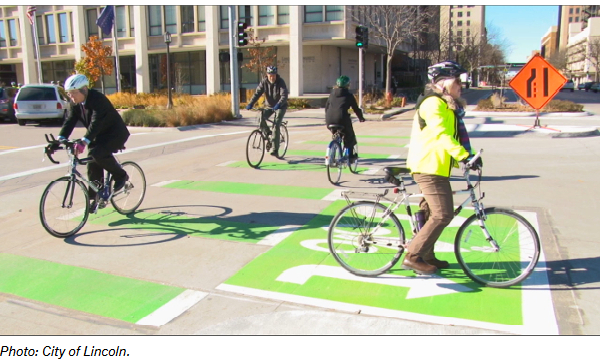This week I’m sharing two articles about making cities safer for cycling that I’ve found interesting. Also, Global Fat Bike Day is this Saturday, December 3, so ride ’em if you’ve got ’em! (But it’s OK to ride whatever you have) Cycle Works in Lincoln and Bellevue Bicycle Club in…Bellevue, are both hosting festivities.

The first article, from route-fifty.com, explains why Washington D.C. is moving towards banning right turns on red. Many Lincoln Cyclists and pedestrians have been hit or nearly hit by the dreaded “right-hook.” That’s where a motorist, while looking towards oncoming traffic, fails to check if the crosswalk or curb side of their lane is occupied by a cyclist or pedestrian while they make a right turn. The motorist may also be turning into a business or driveway and just not be checking for sidewalk users. This is the reason why far more cyclists are hit while riding on the sidewalk than riding in the roadway. From the article:
“The same legislation with the ban on red-light turns also allows cyclists to use the “Idaho stop” at stop signs, essentially allowing them to roll through the intersection to prevent conflicts with stopped vehicles.
The district has also installed “bike boxes” at intersections, where cyclists can wait ahead of queued vehicles; leading pedestrian intervals to let people walk into a crosswalk before cars start moving; zebra stripe patterns at most crosswalks; and ubiquitous curb ramps with tactile warning surfaces.
Brown, from the cyclist group, said those improvements work together with policies like the new turning law to make the district’s streets “less hostile.”
“In isolation, [the new law] is not going to be vastly transformative, but as part of a suite of things, it makes it easier and more comfortable for folks to get around on foot or on a bike,” he said”.

The second article is from the Irish Times, It’s a few years old, but not much has changed since it was written. It talks about how to re-shape Dublin, which used to be a cycling city, by learning from Copenhagen. Nothing successful there couldn’t be replicated here. Some excerpts:
“Copenhagen’s road back to cycling got serious 20 years ago with the basics: the city counted cyclists and began to include cycling-related statistics in their traffic numbers. Then they asked cyclists to rate the existing cycling infrastructure and gained valuable insights into people’s motivations for cycling. More than half of Copenhageners say they cycle simply because it is the quickest way to get from A to B, and more than a third value its convenience. The environmental benefit is a bonus, but only a motivation for 5 per cent of cyclists…
Only after the Danish capital knew its cyclists, their wishes and their motivations did Copenhagen earmark around 900 million krone (€120 million) in the past 15 years for a full overhaul of the cycling network. For each project a simple litmus test was applied: would you be happy letting your child cycle there? If not, a site was earmarked for upgrade, or an upgrade sent back for an overhaul.
The city now issues regular, multiyear bike strategies with defined goals, timelines and financing. Not everything has worked. For instance when the city put cycle lanes on quieter, indirect routes, cyclists refused to use them… “The key is to build a successful cycling infrastructure where cyclists want it, not where you as a city think you have the space,” says Louise Kielgast of Gehl Architects, a leading urban planner in Denmark and around the world.
Could Lincoln become the Copenhagen of the Midwest? Or at least the Boulder? Sure, but it will take more people on bikes making themselves seen and speaking up to become so.
